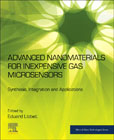
Advanced Nanomaterials for Inexpensive Gas Microsensors: Synthesis, Integration and Applications
Llobet Valero, Eduard
Advanced Nanomaterials for Inexpensive Gas Microsensors presents full coverage of the area of gas sensing nanomaterials, from materials, transducers and applications to the latest advanced results and future directions. A number of experts in the field present work on gas sensing nanomaterials including metal oxides, carbon based and hybrid materials, together with their fabrication and application. The book brings together three major themes: Several chapters address synthesis, functionalization, characterization of advanced nanomaterials, with emphasis on synthesis techniques to ease the integration of nanomaterials in transducers. These chapters encompass a wide spectrum of sensing technologies including advanced nanomaterials such as metal oxides, carbon materials and graphene, organic molecular materials, and atomic layers such as MoS2.The authors examine the coupling of sensitive nanomaterials to different types of transducer elements and their applications, including direct growth and additive fabrication techniques as a way to obtain inexpensive gas microsensors, principal transduction schemes, and advanced operating methods. Assess the value of major applications for gas microsensors, including air quality monitoring both indoors (buildings and vehicles) and outdoors, monitoring perishable goods and medical. For each application, potential issues are clearly identified, research directions to overcome these are suggested, and market analysis data is included. Advanced Nanomaterials for Inexpensive Gas Microsensors presents the latest research and most comprehensive coverage in the field of gas micro and nano sensors for research scientists, academics, graduate students, and R&D managers working on synthesis of nanomaterials and fabrication of sensing systems, in a wide range of areas in electrical and material engineering, physical chemistry, electrochemistry and physics. Presents technological solutions and applications of gas sensors in varied areas of chemistry, physics, material science, and engineeringExamines advanced operating methods (e.g., temperature modulation, self-heating, light-activated response, noise methods) to enhance stability, sensitivity, selectivity and reduce power consumptionProvides a critical review of current applications and their expected future evolution, demonstrating which are the most promising approaches and what can be expected from the development of inexpensive gas micro- and nanosensors INDICE: 1. Introduction 2. Inorganic Nanomaterials3. Organic Materials4. Carbon Nanomaterials5. Hybrid and 2D Nanomaterials6. Fabrication Techniques for Coupling Advanced Nanomaterials to Transducers7. Resistive, Impedance and FET Devices8. Optical Devices9. Resonant Devices 10. Advanced Operating Methods11. Indoor Air Quality Monitoring 12. Outdoor Air Quality Monitoring13. Monitoring Perishable Goods Along the Logistic Chain14. Point of Care/ Personal Breath Analysis Systems15. Applications for the Internet of Things16. Concluding Remarks and Outlook
- ISBN: 978-0-12-814827-3
- Editorial: Elsevier
- Encuadernacion: Rústica
- Páginas: 416
- Fecha Publicación: 01/07/2019
- Nº Volúmenes: 1
- Idioma: Inglés
